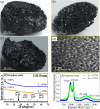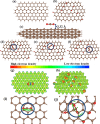Exploring the capture and desorption of CO2 on graphene oxide foams supported by computational calculations
- PMID: 37660192
- PMCID: PMC10475065
- DOI: 10.1038/s41598-023-41683-4
Exploring the capture and desorption of CO2 on graphene oxide foams supported by computational calculations
Erratum in
-
Author Correction: Exploring the capture and desorption of CO2 on graphene oxide foams supported by computational calculations.Sci Rep. 2025 Feb 12;15(1):5291. doi: 10.1038/s41598-025-88643-8. Sci Rep. 2025. PMID: 39939700 Free PMC article. No abstract available.
Abstract
In the last decade, the highest levels of greenhouse gases (GHG) in the atmosphere have been recorded, with carbon dioxide (CO2) being one of the GHGs that most concerns mankind due to the rate at which it is generated on the planet. Given its long time of permanence in the atmosphere (between 100 to 150 years); this has deployed research in the scientific field focused on the absorption and desorption of CO2 in the atmosphere. This work presents the study of CO2 adsorption employing materials based on graphene oxide (GO), such as GO foams with different oxidation percentages (3.00%, 5.25%, and 9.00%) in their structure, obtained via an environmentally friendly method. The characterization of CO2 adsorption was carried out in a closed system, within which were placed the GO foams and other CO2 adsorbent materials (zeolite and silica gel). Through a controlled chemical reaction, production of CO2 was conducted to obtain CO2 concentration curves inside the system and calculate from these the efficiency, obtained between 86.28 and 92.20%, yield between 60.10 and 99.50%, and effectiveness of CO2 adsorption of the materials under study. The results obtained suggest that GO foams are a promising material for carbon capture and the future development of a new clean technology, given their highest CO2 adsorption efficiency and yield.
© 2023. Springer Nature Limited.
Conflict of interest statement
The authors declare no competing interests.
Figures










Similar articles
-
CO2 capture performance of ZrO2-doped Na2CO3/γ-Al2O3 adsorbent.J Environ Sci (China). 2025 Sep;155:382-394. doi: 10.1016/j.jes.2024.09.027. Epub 2024 Oct 10. J Environ Sci (China). 2025. PMID: 40246474
-
Enhancing CO2 capture through innovating monolithic graphene oxide frameworks.Environ Res. 2024 May 15;249:118426. doi: 10.1016/j.envres.2024.118426. Epub 2024 Feb 10. Environ Res. 2024. PMID: 38342202
-
Polyethylene glycol/silica and carbon black/silica xerogel composites as an adsorbent for CO2 capture.Turk J Chem. 2021 Oct 17;45(6):2013-2023. doi: 10.3906/kim-2101-45. eCollection 2021. Turk J Chem. 2021. PMID: 38144585 Free PMC article.
-
A critical review on graphene and graphene-based derivatives from natural sources emphasizing on CO2 adsorption potential.Environ Sci Pollut Res Int. 2024 Dec;31(60):67633-67663. doi: 10.1007/s11356-023-30093-8. Epub 2023 Oct 2. Environ Sci Pollut Res Int. 2024. PMID: 37779125 Review.
-
Advancements in adsorption based carbon dioxide capture technologies- A comprehensive review.Heliyon. 2023 Nov 15;9(12):e22341. doi: 10.1016/j.heliyon.2023.e22341. eCollection 2023 Dec. Heliyon. 2023. PMID: 38076159 Free PMC article. Review.
Cited by
-
Pyridinic-N Coordination Effect on the Adsorption and Activation of CO2 by Single Vacancy Iron-Doped Graphene.Langmuir. 2024 Apr 2;40(13):6703-6717. doi: 10.1021/acs.langmuir.3c03327. Epub 2024 Mar 18. Langmuir. 2024. PMID: 38498309 Free PMC article.
-
Nanoporous Metatitanic acid on γ-Al2O3 aerogel for higher CO2 adsorption capacity and lower energy consumption.Sci Rep. 2024 Oct 2;14(1):22905. doi: 10.1038/s41598-024-74203-z. Sci Rep. 2024. PMID: 39358431 Free PMC article.
-
Study of the Electronic Structure of Coronene Doped with Nitrogen Atoms and Its Effect on CO2 Capture.ACS Omega. 2025 Apr 16;10(16):16559-16578. doi: 10.1021/acsomega.4c11531. eCollection 2025 Apr 29. ACS Omega. 2025. PMID: 40321537 Free PMC article.
References
-
- Bandilla, K. W. Carbon capture and storage. in Future Energy: Improved, Sustainable and Clean Options for Our Planet, 669–692. 10.1016/B978-0-08-102886-5.00031-1 (2020).
-
- Zhang, Z., Borhani, T. N. G. & El-Naas, M. H. Carbon capture. in Exergetic, Energetic and Environmental Dimensions, 997–1016. 10.1016/B978-0-12-813734-5.00056-1 (2018).
-
- Yang, M., Ma, C., Xu, M., Wang, S. & Xu, L. Recent advances in CO2 adsorption from air: A review. Curr. Pollut. Rep.5, 272–293. 10.1007/s40726-019-00128-1 (2019).
-
- Kuwahara, Y. et al. Enhanced CO2 adsorption over polymeric amines supported on heteroatom-incorporated SBA-15 silica: Impact of heteroatom type and loading on sorbent structure and adsorption performance. Chem. Eur. J.18, 16649–16664. 10.1002/chem.201203144 (2012). - PubMed
-
- Goeppert, A. et al. Easily regenerable solid adsorbents based on polyamines for carbon dioxide capture from the air. Chem. Sus. Chem.7, 1386–1397. 10.1002/cssc.201301114 (2014). - PubMed
LinkOut - more resources
Full Text Sources

